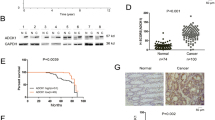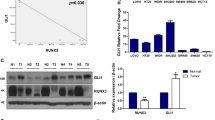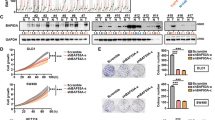Abstract
SPROUTY2 (SPRY2) is an intracellular regulator of receptor tyrosine kinase signaling involved in cell growth, differentiation and tumorigenesis. Here, we show that SPRY2 is a target gene of the Wnt/β-catenin pathway that is abnormally activated in more than 90% of colon carcinomas. In human colon cancer cells, SPRY2 expression is induced by β-catenin in co-operation with the transcription factor FOXO3a instead of lymphoid enhancer factor/T-cell factor proteins. We found binding of β-catenin to the SPRY2 promoter at FOXO3a response elements. In vivo, cells marked by nuclear β-catenin and FOXO3a express SPRY2 in proliferative epithelial tissues, such as intestinal mucosa and epidermis. Consistently, inducible β-catenin deletion in mice reduced Spry2 expression in the small intestine. Moreover, SPRY2 protein expression correlated with nuclear β-catenin and FOXO3a colocalization in human colon carcinomas. Importantly, the amount of SPRY2 protein correlated with shorter overall survival of colon cancer patients. Our data reveal SPRY2 as a novel Wnt/β-catenin and FOXO3a target gene indicative of poor prognosis in colon cancer.
This is a preview of subscription content, access via your institution
Access options
Subscribe to this journal
Receive 50 print issues and online access
$259.00 per year
only $5.18 per issue
Buy this article
- Purchase on Springer Link
- Instant access to full article PDF
Prices may be subject to local taxes which are calculated during checkout






Similar content being viewed by others
References
Jemal A, Bray F, Center MM, Ferlay J, Ward E, Forman D . Global cancer statistics. CA: A Cancer Journal for Clinicians 2011; 61 (2): 69–90.
Kinzler KW, Vogelstein B . Lessons from hereditary colorectal cancer. Cell 1996; 87: 159–170.
van de Wetering M, Sancho E, Verweij C, de Lau W, Oving I, Hurlstone A et al. The beta-catenin/TCF-4 complex imposes a crypt progenitor phenotype on colorectal cancer cells. Cell 2002; 111: 241–250.
Palmer HG . Vitamin D3 promotes the differentiation of colon carcinoma cells by the induction of E-cadherin and the inhibition of beta-catenin signaling. J Cell Biol 2001; 154: 369–388.
Palmer HG, Anjos-Afonso F, Carmeliet G, Takeda H, Watt FM . The vitamin D receptor is a Wnt effector that controls hair follicle differentiation and specifies tumor type in adult epidermis. PLoS ONE 2008; 3: e1483.
Olson LE, Tollkuhn J, Scafoglio C, Krones A, Zhang J, Ohgi KA et al. Homeodomain-mediated beta-catenin-dependent switching events dictate cell-lineage determination. Cell 2006; 125: 593–605.
Mulholland DJ, Dedhar S, Coetzee GA, Nelson CC . Interaction of nuclear receptors with the Wnt/beta-catenin/Tcf signaling axis: Wnt you like to know? Endocr Rev. Endocr Rev 2005; 26: 898–915.
Tenbaum SP, Ordonez-Moran P, Puig I, Chicote I, Arques O, Landolfi S et al. beta-catenin confers resistance to PI3K and AKT inhibitors and subverts FOXO3a to promote metastasis in colon cancer. Nat Med 2012; 18: 892–901.
Calnan DR, Brunet A . The FoxO code. Oncogene 2008; 27: 2276–2288.
Hoogeboom D, Essers MA, Polderman PE, Voets E, Smits LM, Burgering BM . Interaction of FOXO with beta-catenin inhibits beta-catenin/T cell factor activity. J Biol Chem 2008; 283: 9224–9230.
Essers MA, de Vries-Smits LM, Barker N, Polderman PE, Burgering BM, Korswagen HC . Functional interaction between beta-catenin and FOXO in oxidative stress signaling. Science 2005; 308: 1181–1184.
Paik JH, Kollipara R, Chu G, Ji H, Xiao Y, Ding Z et al. FoxOs are lineage-restricted redundant tumor suppressors and regulate endothelial cell homeostasis. Cell 2007; 128: 309–323.
Lo TL, Fong CW, Yusoff P, McKie AB, Chua MS, Leung HY et al. Sprouty and cancer: the first terms report. Cancer lett 2006; 242: 141–150.
Fong CW, Chua MS, McKie AB, Ling SH, Mason V, Li R et al. Sprouty 2, an inhibitor of mitogen-activated protein kinase signaling, is down-regulated in hepatocellular carcinoma. Cancer Res 2006; 66: 2048–2058.
Sanchez A, Setien F, Martinez N, Oliva JL, Herranz M, Fraga MF et al. Epigenetic inactivation of the ERK inhibitor Spry2 in B-cell diffuse lymphomas. Oncogene 2008; 27: 4969–4972.
Frank MJ, Dawson DW, Bensinger SJ, Hong JS, Knosp WM, Xu L et al. Expression of sprouty2 inhibits B-cell proliferation and is epigenetically silenced in mouse and human B-cell lymphomas. Blood 2009; 113: 2478–2487.
Song K, Gao Q, Zhou J, Qiu SJ, Huang XW, Wang XY et al. Prognostic significance and clinical relevance of Sprouty 2 protein expression in human hepatocellular carcinoma. Hepatobiliary Pancreat Dis Int 2012; 11: 177–184.
Bloethner S, Chen B, Hemminki K, Muller-Berghaus J, Ugurel S, Schadendorf D et al. Effect of common B-RAF and N-RAS mutations on global gene expression in melanoma cell lines. Carcinogenesis 2005; 26: 1224–1232.
Tsavachidou D, Coleman ML, Athanasiadis G, Li S, Licht JD, Olson MF et al. SPRY2 is an inhibitor of the ras/extracellular signal-regulated kinase pathway in melanocytes and melanoma cells with wild-type BRAF but not with the V599E mutant. Cancer Res 2004; 64: 5556–5559.
Barbachano A, Ordonez-Moran P, Garcia JM, Sanchez A, Pereira F, Larriba MJ et al. SPROUTY-2 and E-cadherin regulate reciprocally and dictate colon cancer cell tumourigenicity. Oncogene 2010; 29: 4800–4813.
Holgren C, Dougherty U, Edwin F, Cerasi D, Taylor I, Fichera A et al. Sprouty-2 controls c-Met expression and metastatic potential of colon cancer cells: sprouty/c-Met upregulation in human colonic adenocarcinomas. Oncogene 2010; 29: 5241–5253.
Silva-Vargas V, Lo Celso C, Giangreco A, Ofstad T, Prowse DM, Braun KM et al. Beta-catenin and Hedgehog signal strength can specify number and location of hair follicles in adult epidermis without recruitment of bulge stem cells. Dev Cell 2005; 9: 121–131.
Dijkers PF, Medema RH, Lammers JW, Koenderman L, Coffer PJ . Expression of the pro-apoptotic Bcl-2 family member Bim is regulated by the forkhead transcription factor FKHR-L1. Curr Biol 2000; 10: 1201–1204.
Impagnatiello MA, Weitzer S, Gannon G, Compagni A, Cotten M, Christofori G . Mammalian sprouty-1 and -2 are membrane-anchored phosphoprotein inhibitors of growth factor signaling in endothelial cells. J Cell Biol 2001; 152: 1087–1098.
DaSilva J, Xu L, Kim HJ, Miller WT, Bar-Sagi D . Regulation of sprouty stability by Mnk1-dependent phosphorylation. Mol Cell Biol 2006; 26: 1898–1907.
Lao DH, Yusoff P, Chandramouli S, Philp RJ, Fong CW, Jackson RA et al. Direct binding of PP2A to Sprouty2 and phosphorylation changes are a prerequisite for ERK inhibition downstream of fibroblast growth factor receptor stimulation. J Biol Chem 2007; 282: 9117–9126.
Van der Flier LG, Sabates-Bellver J, Oving I, Haegebarth A, De Palo M, Anti M et al. The intestinal Wnt/TCF signature. Gastroenterology 2007; 132: 628–632.
Fevr T, Robine S, Louvard D, Huelsken J . Wnt/beta-catenin is essential for intestinal homeostasis and maintenance of intestinal stem cells. Mol Cell Biol 2007; 27: 7551–7559.
Mason JM, Morrison DJ, Basson MA, Licht JD . Sprouty proteins: multifaceted negative-feedback regulators of receptor tyrosine kinase signaling. Trends Cell Biol 2006; 16: 45–54.
Christofori G . Split personalities: the agonistic antagonist Sprouty. Nat Cell Biol 2003; 5: 377–379.
Guy GR, Jackson RA, Yusoff P, Chow SY . Sprouty proteins: modified modulators, matchmakers or missing links? J Endocrinol 2009; 203: 191–202.
Cabrita MA, Christofori G . Sprouty proteins, masterminds of receptor tyrosine kinase signaling. Angiogenesis 2008; 11: 53–62.
Fiske WH, Threadgill D, Coffey RJ . ERBBs in the gastrointestinal tract: recent progress and new perspectives. Exp Cell Res 2009; 315: 583–601.
Fong CW, Leong HF, Wong ES, Lim J, Yusoff P, Guy GR . Tyrosine phosphorylation of Sprouty2 enhances its interaction with c-Cbl and is crucial for its function. J Biol Chem 2003; 278: 33456–33464.
Wong ES, Fong CW, Lim J, Yusoff P, Low BC, Langdon WY et al. Sprouty2 attenuates epidermal growth factor receptor ubiquitylation and endocytosis, and consequently enhances Ras/ERK signalling. Embo J 2002; 21: 4796–4808.
Haglund K, Schmidt MH, Wong ES, Guy GR, Dikic I . Sprouty2 acts at the Cbl/CIN85 interface to inhibit epidermal growth factor receptor downregulation. EMBO Rep 2005; 6: 635–641.
Kim HJ, Taylor LJ, Bar-Sagi D . Spatial regulation of EGFR signaling by Sprouty2. Curr Biol 2007; 17: 455–461.
Egan JE, Hall AB, Yatsula BA, Bar-Sagi D . The bimodal regulation of epidermal growth factor signaling by human Sprouty proteins. Proc Natl Acad Sci USA 2002; 99: 6041–6046.
Hanafusa H, Torii S, Yasunaga T, Nishida E Sprouty1 . and Sprouty2 provide a control mechanism for the Ras/MAPK signalling pathway. Nat Cell Biol 2002; 4: 850–858.
Schneider MR, Werner S, Paus R, Wolf E . Beyond wavy hairs: the epidermal growth factor receptor and its ligands in skin biology and pathology. Am J Pathol 2008; 173: 14–24.
Barker N, Clevers H . Tracking down the stem cells of the intestine: strategies to identify adult stem cells. Gastroenterology 2007; 133: 1755–1760.
Watt FM, Jensen KB . Epidermal stem cell diversity and quiescence. EMBO Mol Med 2009; 1: 260–267.
Jensen KB, Collins CA, Nascimento E, Tan DW, Frye M, Itami S et al. Lrig1 expression defines a distinct multipotent stem cell population in mammalian epidermis. Cell stem cell 2009; 4: 427–439.
Shim K, Minowada G, Coling DE, Martin GR . Sprouty2, a mouse deafness gene, regulates cell fate decisions in the auditory sensory epithelium by antagonizing FGF signaling. Dev Cell 2005; 8: 553–564.
Cunningham D, Humblet Y, Siena S, Khayat D, Bleiberg H, Santoro A et al. Cetuximab monotherapy and cetuximab plus irinotecan in irinotecan-refractory metastatic colorectal cancer. N Engl J Med 2004; 351: 337–345.
Dijkers PF, Medema RH, Pals C, Banerji L, Thomas NS, Lam EW et al. Forkhead transcription factor FKHR-L1 modulates cytokine-dependent transcriptional regulation of p27(KIP1). Mol Cell Biol 2000; 20: 9138–9148.
Raghav SK, Deplancke B . Genome-wide profiling of DNA-binding proteins using barcode-based multiplex Solexa sequencing. Methods Mol Biol 2012; 786: 247–262.
Filali M, Cheng N, Abbott D, Leontiev V, Engelhardt JF . Wnt-3A/beta-catenin signaling induces transcription from the LEF-1 promoter. J Biol Chem 2002; 6 277: 33398–33410.
Ding W, Bellusci S, Shi W, Warburton D . Functional analysis of the human Sprouty2 gene promoter. Gene 2003; 322: 175–185.
Korinek V, Barker N, Morin PJ, van Wichen D, de Weger R, Kinzler KW et al. Constitutive transcriptional activation by a beta-catenin-Tcf complex in APC−/− colon carcinoma. Science 1997; 275 1784-7.
Oriol A, Irene C, Stephan T, Isabel P, Héctor GP . Standardized Relative Quantification of Immunofluorescence Tissue Staining. H.G. Palmer's Lab, Stem Cells and Cancer. Protocol Exchange (e-pub ahead of print 2 April 2012).
Acknowledgements
We thank T Martínez for technical assistance and Hans Clevers for providing the LS174T-tetOn-ΔNTCF4 cells. Experiments were supported by grants from Fondo Europeo de Desarrollo Regional-Instituto de Salud Carlos III and Spanish Cooperative Research Network on Cancer (RTICC) (FIS-PI081356, RD12/0036/0001, RD12/0036/0021 and RD12/0036/0012), Plan Nacional de Biomedicina, Ministerio de Economía y Competitividad (SAF-18302) and Comunidad de Madrid (S2010/BMD-2344 Colomics2). HGP was supported by the Miguel Servet Program, Instituto de Salud Carlos III (ISCIII) and PO-M by an EMBO research fellowship.
Author information
Authors and Affiliations
Corresponding author
Ethics declarations
Competing interests
The authors declare no conflict of interest.
Additional information
Supplementary Information accompanies this paper on the Oncogene website
Rights and permissions
About this article
Cite this article
Ordóñez-Morán, P., Irmisch, A., Barbáchano, A. et al. SPROUTY2 is a β-catenin and FOXO3a target gene indicative of poor prognosis in colon cancer. Oncogene 33, 1975–1985 (2014). https://doi.org/10.1038/onc.2013.140
Received:
Revised:
Accepted:
Published:
Issue Date:
DOI: https://doi.org/10.1038/onc.2013.140
Keywords
This article is cited by
-
FOXO3a-interacting proteins’ involvement in cancer: a review
Molecular Biology Reports (2024)
-
MeCP2 inhibits ischemic neuronal injury by enhancing methylation of the FOXO3a promoter to repress the SPRY2-ZEB1 axis
Experimental & Molecular Medicine (2022)
-
Loss of Spry1 reduces growth of BRAFV600-mutant cutaneous melanoma and improves response to targeted therapy
Cell Death & Disease (2020)
-
Atypical role of sprouty in colorectal cancer: sprouty repression inhibits epithelial–mesenchymal transition
Oncogene (2016)
-
SPROUTY-2 represses the epithelial phenotype of colon carcinoma cells via upregulation of ZEB1 mediated by ETS1 and miR-200/miR-150
Oncogene (2016)



